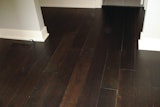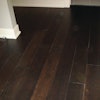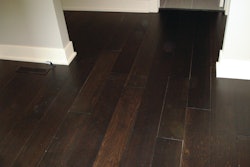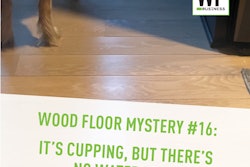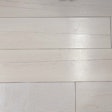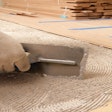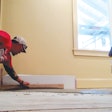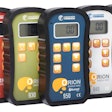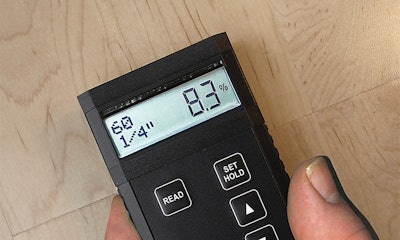
Measuring moisture before you install wood flooring is extremely important, but sometimes it can be difficult to know how to measure the moisture for the product you are testing. Here are tips that will help you get accurate readings.
Tips for testing solid flooring
Both pin and pinless moisture meters need to be corrected for the wood species. With a solid floor, there is no question which setting should be used—the correct setting should be available from the meter manufacturer. Most offer a list of built-in corrections for species for both pin and pinless meters. These corrections are done by inputting a code number before taking measurements.
Know that correction settings for pin versus pinless meters are different because of their different measuring principles. Corrections for pinless meters are dependent on the specific gravity of the wood species. For instance, the correction setting for red oak is 60; the average specific gravity of red oak is 0.6. Wood species with the same specific gravity can be measured with the same correction settings.
Correction settings for pin meters are calculated after an oven test has been performed—there is no correlation of pin meter corrections to the specific gravity. Because of this, if you are looking for the setting for an unlisted wood, you cannot refer to its specific gravity.
Strategies for engineered wood
The big question is: How can the right correction settings be found when dealing with engineered floors with different layers of different wood species? Some engineered floors may be measured with the species setting of the wear layer, but for others the correct setting is different. Even looking only at engineered oak floors, there are many types, from thickness of wear layer and wood species to the core material and number of core layers. To get accurate readings, the correction setting has to be found for each product.
I suggest starting with a few well-acclimated sample pieces, such as from a showroom or after acclimation on-site. If the average RH where the flooring was kept was around 45%, then the MC of the sample pieces should be around 8.5%. (If the RH is different, use an EMC chart to find the corresponding MC). After it is established that the sample pieces are at 8.5% (or whatever EMC you are using), change the settings until the meter indicates 8.5% when measuring the sample piece. In the future, that type of floor can be measured with the same setting.
RELATED: Understand Wood Floor Moisture Content & Dimensional Change
If no acclimated sample piece is available, set the meter to the wood species of the wear layer and check the wood. Consider the readings you get to be comparative measurements (see more on that below). The values will at least indicate if all samples have the same MC. If you use the meter to track acclimation, the measurements will indicate when no more changes in MC occur.
Measuring bamboo flooring
I've used that same principle to find settings when measuring bamboo. Some moisture meters use bamboo-specific calibrations based on what is called the wood moisture equivalent (WME). For example, if bamboo was acclimated beside a piece of wood and the wood reads 12%, then the meter would be adjusted to read 12% when measuring bamboo. When measuring bamboo, ask the meter manufacturer for their directions.
Taking comparative readings
Another technique for when you aren't sure what moisture meter setting to use is to compare readings taken in multiple boards over time. All pieces with the same MC or higher values mean more moisture, and of course lower values mean less moisture. This can only be applied if the measurements are taken with the same correction setting in the meter at the same depth. This method is more meaningful if a dry piece of the material is available so the measurements can be compared to the dry value.
With many new flooring products (LVT is just one example) being introduced, it becomes hard to find the correct settings for the meter, so the comparative method is becoming more common.
Measuring moisture is an important task for anyone dealing with wood floors, starting with manufacturing up to installation. If moisture problems occur, it is helpful if there are moisture records. Obtaining moisture measurements and keeping records gives you the key to understanding problems.
RELATED: Avoid These Mistakes When Moisture Testing Wood Floors











